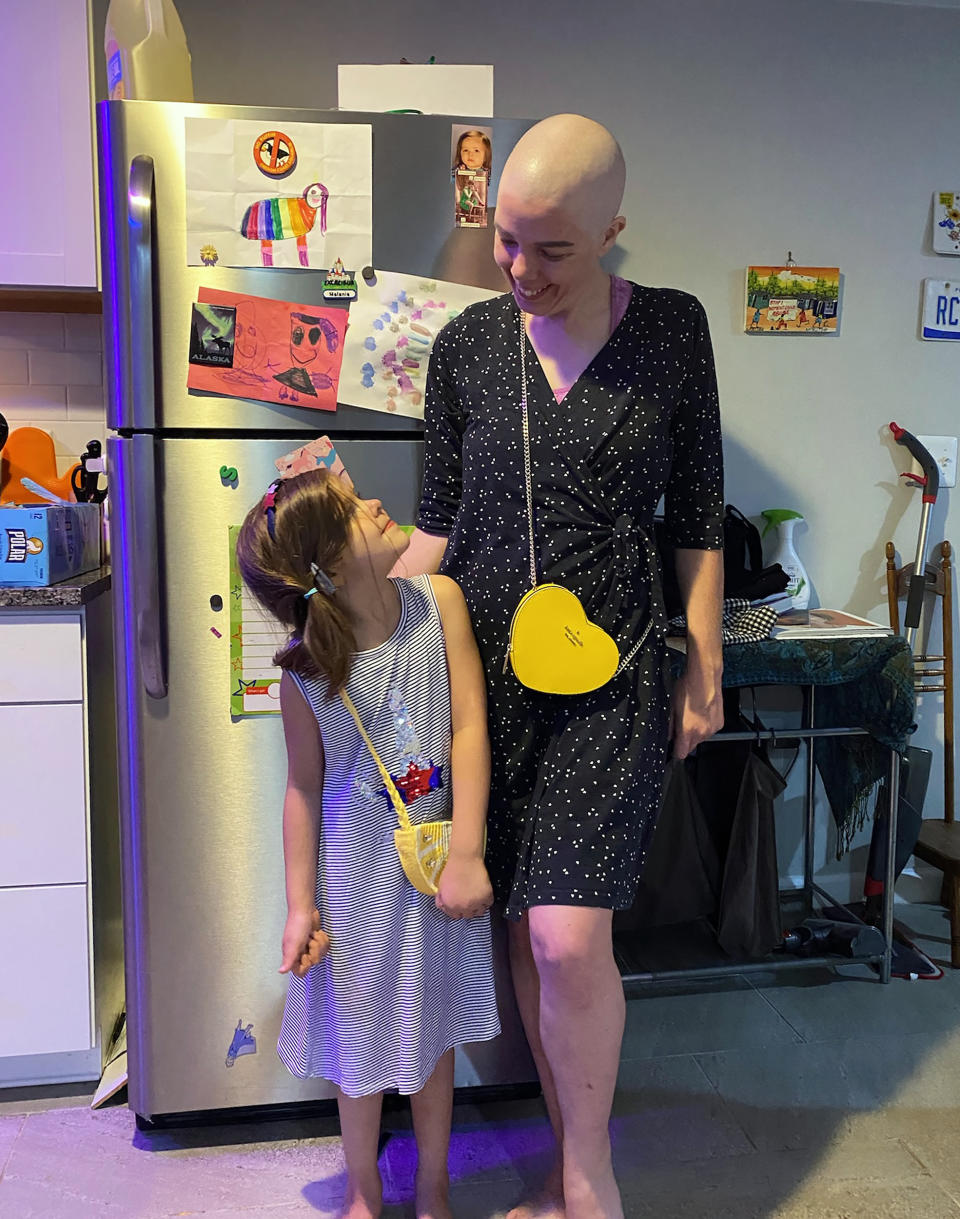Her arm randomly started to flail. Doctors said it was her medicine. It was Parkinson's
In 2017, Melanie Carlson, then 35, received a shocking diagnosis: Parkinson’s disease. Soon after, she developed tremors and hyperkinetic, or “jerking and twisting,” limb movements, she recalls.
“It’s a painful movement disorder,” Carlson, 41, of Washington D.C., tells TODAY.com. “It just kept getting worse and worse to where I have a little roller board, like you have in kindergarten, and I was using that to scoot around my house. I was crawling. I was falling all the time.”
Carlson stopped leaving her house because the hyperkinetic movement became so unpredictable. Frustrated, she started looking online for possible solutions and found a new procedure that can reduce or eliminate tremors and hyperkinetic movement. Last summer, she underwent focused ultrasound ablation.
“I can only speak for myself, but it was like this immediate relaxation,” she says. “You’re so used to your body being so tense and hyperkinetic, and I walked right out of there.”
5 weeks post-brain surgery! Focused ultrasound is a miracle ✨breakthrough for people with Parkinson’s!! ❤️💯
Don’t lose hope & miracles are real 😘 💋 #parkinsonsawareness pic.twitter.com/NdX8STTzHj— Mx. Defying 🎶 🎟️ 🙌 (@Mx_Defying) July 11, 2022
Parkinson’s diagnosis
In 2014, Carlson woke up one morning, and her right arm flailed listlessly. Worried, she asked her doctor, who thought it might be because of a medication she was taking, so she weaned off it.
When she gave birth three years later, she experienced postpartum psychosis, and doctors put her on the same medication. This time, she experienced muscle rigidity and dystonia, a type of cramping, which led to her Parkinson's diagnosis. She started medications for the condition but developed dyskinesia, a common side effect of the drugs.
“All of a sudden, you can be in the middle of the store and not able to walk anymore, and the strange thing about Parkinson’s is I could run or skip, but I could not walk anymore. So, I would run out of stores,” she says. “Most of my time, I was just sitting or lying down because I didn’t have symptoms ... unless I was trying to move.”

Carlson was in a Ph.D. program and had to step away because of her health. She also worried about caring for her daughter.
“Having a toddler, I was terrified. It is scary even if you’re able-bodied,” she says. “I was so scared all the time. I fell into a wall, and I gave myself a black eye. I had bruises.”
Being in public felt alienating because people misunderstood her condition.
“I was trying to go out for my friend’s birthday party, and it was in New York City, and the guy’s like, ‘You’re too drunk to come in.” And I’m like, ‘I haven’t been drinking anything,’” Carlson recalls. “It’s very isolating because such a pronounced disability is so noticeable. … People respond negatively.”
So often, Carlson felt exhausted. She needed to navigate her physical world but also devote a lot of mental energy to it because “daily tasks are logistically hard,” she explains.
No longer could she have engaging chats with friends about politics or pop culture because she was so focusing on getting through everyday life and caring for herself and her daughter.
“It’s just so disabling,” she says.
Carlson hoped to get some help when she started researching treatments for hyperkinetic movement and Parkinson’s. She found a group conducting ultrasound surgery to correct the area of the brain causing these movements. She immediately reached out.
“I knew with the surgery there could be complications. There’s always a risk,” she says. “It’s the cutting edge of technology.”

Ultrasound treatment for Parkinson’s
Parkinson’s disease is a neurodegenerative condition that causes movement problems and cognitive changes, says Dr. Howard Eisenberg, a professor of neurosurgery at the University of Maryland School of Medicine and a neurosurgeon at the University of Maryland Medical Center, who treated Carlson.
“It’s one of the more common neurodegenerative diseases,” the neurosurgeon tells TODAY.com. “Parkinson’s disease has the motor symptoms — tremors, for example, rigidity, slowness of movement. But it also has other symptoms, and sometimes people progress on to dementia, for example. It’s a complicated disease.”
Eisenberg participated as a researcher in a study looking at how people with Parkinson's disease-caused movement problems responded to focused ultrasound ablation compared a control group of those who received a sham treatment. Ablation refers to the removal of a body part or destroying its ability to function — in this case, disabling the part of the brain triggering the movements.
Of the 69 patients who had ultrasound ablation, 69% responded to the treatment, according to the research in the New England Journal of Medicine. How long do the effects last? “It’s durable, (but) it’s not perfectly durable,” Eisenberg says. “One of the complications is the effects could fade away, but the durability is good.”
For people with Parkinson’s and other movement problems who don't respond to medication, deep brain stimulation, which requires brain surgery and the implantation of a device, is considered the gold standard, Eisenberg explains.
Ultrasound ablation, on the other hand, isn't "typical neurosurgery. You don’t need a scalpel to open the head,” Eisenberg says. “It’s (another) option for people who failed medical treatment.”
For the procedure, a patient undergoes an MRI so doctors can pinpoint the region undergoing the ultrasound ablation. They first test the area with low levels of ultrasound to make sure they are targeting the correct neurons and then increase the ultrasound, so it converts to energy that turns into heat. That heat “knocks out a small cluster of neurons” that contribute the movement problems, according to Eisenberg. There are no incisions necessary.
“It’s not that these neurons are causing the Parkinson’s disease, but the movement is controlled by the brain in very complicated pathways,” he says. “What’s happening here is that you’re interrupting the pathways. We’re rerouting or redesigning a circuit in the brain.”
While the U.S. Food and Drug Administration has approved the procedure, the Centers for Medicare and Medicaid Services has not approved it for insurance coverage, meaning many patients need to find their own funding to undergo it.
“Usually, when the FDA approves something, CMS generally will approve it, but it takes a while,” Eisenberg says.
Even still, Eisenberg says that other medical centers are embracing ultrasound ablation as a treatment for movement disorders or Parkinson's disease.
Offering hope
The MRIs and ultrasound altogether took about four hours. Toward the end, Carlson experienced some discomfort.
“It’s not pain free, but it’s not bad because the duration is short,” she says. “It’s ultrasonic waves that are blasting a tiny part of your brain that’s malfunctioning.”

When Carlson walked out of the procedure without a painful, jerking gait, she felt thrilled.
“I was actually surprised after how I cried a lot because you realize how hard your life was. It’s such a trauma,” she says. “It’s really a sense of relief.”
Even though Carlson is still living with a neurodegenerative disease that has no cure, life without dyskinesia is sweeter. On social media she shared a before and after video showing the difference in how she moves.
She's able to take her daughter, Aurora, 6, out in public without stares or fear of hurting her or herself. Brushing Aurora's hair or tying her shoes are small tasks that Carlson's grateful to do again.
Before, “I didn’t like taking her anywhere," Carlson says. But more recently, "I took her to Chuck E. Cheese over the weekend, the trampoline park. ... I’m hoping that people with my constellation of symptoms can see this, and be like, ‘Oh my God, I didn’t know that existed.’ There’s hope."
This article was originally published on TODAY.com

